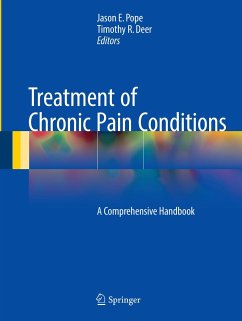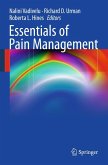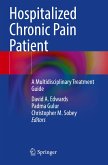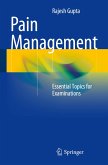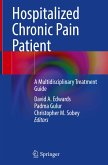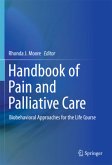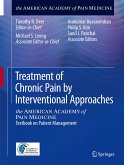Treatment of Chronic Pain Conditions
A Comprehensive Handbook
Herausgegeben:Pope, Jason E.; Deer, Timothy R
Treatment of Chronic Pain Conditions
A Comprehensive Handbook
Herausgegeben:Pope, Jason E.; Deer, Timothy R
- Broschiertes Buch
- Merkliste
- Auf die Merkliste
- Bewerten Bewerten
- Teilen
- Produkt teilen
- Produkterinnerung
- Produkterinnerung
There is an unmet need in both acute and chronic care settings for a comprehensive, clinically focused, fast reference on pain management. Written by high-profile, internationally recognized experts in field, Pain Treatment for Acute and Chronic Conditions: A Comprehensive Handbook is one of the first manuals of its kind to provide balanced and comprehensive coverage of pain medicine modalities. The book is structured into sixteen sections with each chapter providing key points for quick reference, followed by a more detailed overview of the topic at hand with extensive tables and figures to…mehr
Andere Kunden interessierten sich auch für
![Essentials of Pain Management Essentials of Pain Management]() Essentials of Pain Management82,99 €
Essentials of Pain Management82,99 €![Hospitalized Chronic Pain Patient Hospitalized Chronic Pain Patient]() Hospitalized Chronic Pain Patient41,99 €
Hospitalized Chronic Pain Patient41,99 €![Multiple Choice Questions in Pain Management Multiple Choice Questions in Pain Management]() Rajesh GuptaMultiple Choice Questions in Pain Management53,99 €
Rajesh GuptaMultiple Choice Questions in Pain Management53,99 €![Pain Management Pain Management]() Rajesh GuptaPain Management41,99 €
Rajesh GuptaPain Management41,99 €![Hospitalized Chronic Pain Patient Hospitalized Chronic Pain Patient]() Hospitalized Chronic Pain Patient41,99 €
Hospitalized Chronic Pain Patient41,99 €![Handbook of Pain and Palliative Care Handbook of Pain and Palliative Care]() Handbook of Pain and Palliative Care442,99 €
Handbook of Pain and Palliative Care442,99 €![Treatment of Chronic Pain by Interventional Approaches Treatment of Chronic Pain by Interventional Approaches]() Treatment of Chronic Pain by Interventional Approaches122,99 €
Treatment of Chronic Pain by Interventional Approaches122,99 €-
-
-
There is an unmet need in both acute and chronic care settings for a comprehensive, clinically focused, fast reference on pain management. Written by high-profile, internationally recognized experts in field, Pain Treatment for Acute and Chronic Conditions: A Comprehensive Handbook is one of the first manuals of its kind to provide balanced and comprehensive coverage of pain medicine modalities. The book is structured into sixteen sections with each chapter providing key points for quick reference, followed by a more detailed overview of the topic at hand with extensive tables and figures to illustrate. Beautifully laid out and extensively furnished with both research and experience, this book is a necessary resource in the field of pain medicine.
Produktdetails
- Produktdetails
- Verlag: Springer / Springer New York / Springer, Berlin
- Artikelnr. des Verlages: 978-1-4939-6974-6
- 1st ed. 2017
- Seitenzahl: 376
- Erscheinungstermin: 2. September 2017
- Englisch
- Abmessung: 279mm x 210mm x 21mm
- Gewicht: 948g
- ISBN-13: 9781493969746
- ISBN-10: 1493969749
- Artikelnr.: 47493749
- Herstellerkennzeichnung Die Herstellerinformationen sind derzeit nicht verfügbar.
- Verlag: Springer / Springer New York / Springer, Berlin
- Artikelnr. des Verlages: 978-1-4939-6974-6
- 1st ed. 2017
- Seitenzahl: 376
- Erscheinungstermin: 2. September 2017
- Englisch
- Abmessung: 279mm x 210mm x 21mm
- Gewicht: 948g
- ISBN-13: 9781493969746
- ISBN-10: 1493969749
- Artikelnr.: 47493749
- Herstellerkennzeichnung Die Herstellerinformationen sind derzeit nicht verfügbar.
Timothy R. Deer, MD The Center for Pain Relief Charleston, WV Jason E. Pope, MD Summit Pain Alliance Santa Rosa, CA
The Basics: I. Background Focus.- Chapter 1 Chronic Pain.- Chapter 2 Mechanisms of Chronic Pain.- Chapter 3 Overview of Chronic Pain.- The Basics: II. Anatomy.- Chapter 4 Anatomy of the Spine.- Chapter 5 Peripheral Pathways and Anatomy of the Peripheral Nerve.- Evaluation and Assessment: III. History and Physical.- Chapter 6 Evaluation of Headache.- Chapter 7 Cervical Spine History & Physical.- Chapter 8 History and Physical Examination of the Thoracic Spine.- Chapter 9 Lumbar Spine History and Physical.- Chapter 10 Upper Extremity Physical Examination.- Chapter 11 Lower Extremity Physical Examination.- Chapter 12 History and Physical Examination for Neuropathy.- Chapter 13 History and Physical Exam: Systemic Rheumatologic Disorders.- Evaluation and Assessment: IV. Imaging and EMG/NCV.- Chapter 14 Indications /Interpretation for Advanced Imaging: MRI and CT.- Chapter 15 Indications for/Interpretation of Electrodiagnostic Testing.- Evaluation and Assessment: V. Surgical Referral.- Chapter 16 Indications for Surgery for Low Back Pain.- Conservative Treatment: VI. Medical Conservative Care.- Chapter 17 Spectrum of Pain Care.- Chapter 18 Chronic Pain Rehabilitative Programs.- Chapter 19 Physical Therapy in the Management of Chronic Pain.- Chapter 20 Opioid Medications for Chronic Non-Cancer Pain.- Chapter 21 Non-Steroidal Anti-Inflammatory Drugs (NSAIDS).- Chapter 22 Anticonvulsants.- Chapter 23 Antidepressants.- Chapter 24 Antispasmodics.- Chapter 25 Steroids.- Conservative Treatment: VII. Interventional Conservative Care.- Chapter 26 Radiologic Safety in Interventional Spine and Pain Medicine.- Chapter 27 Interventional Conservative Care: Trigger Points.- Chapter 28 Knee Injection.- Chapter 29 Interventional Conservative Care: Ankle injection.- Chapter 30 Hip Injections.- Chapter 31 Occipital Nerve Block.- Chapter 32 Trigeminal Nerve Block.- Chapter 33 Sphenopalatine Ganglion.- Chapter 34 Auriculo-temporal Nerve Block.- Chapter 35 GlossopharyngealNeuralgia.- Chapter 36 Atlanto-Occipital and Atlanto-Axial Joint Injections.- Chapter 37 Facet Medial Branch Block.- Chapter 38 Facet Medial Branch Ablation.- Chapter 39 Epidural Analgesia in Chronic Pain Management.- Chapter 40 Stellate Ganglion Blockade.- Chapter 41 Celiac Plexus Block.- Chapter 42 Lumbar Sympathetic Block.- Chapter 43 Superior Hypogastric Plexus Blockade.- Chapter 44 Ganglion Impar Block.- Chapter 45 Vertebral Augmentation.- Chapter 46 Discography.- Chapter 47 Management of Iatrogenic Emergencies in Interventional Pain Management.- Chapter 48 Regenerative Medicine.- Chapter 49 Sacroiliac Joint Dysfunction.- Chapter 50 Platelet Rich Plasma.- Advanced Pain Care Therapies: VIII. Intrathecal Drug Delivery.- Chapter 51 Intrathecal Drug Delivery Indications.- Chapter 52 Intrathecal Drug Delivery Trialing Strategies.- Chapter 53 Intrathecal Drug Delivery: Available Technologies.- Chapter 54 Intrathecal drug delivery Implantation.- Chapter 55 Intrathecal Drug Delivery: Maintenance.- Chapter 56 PACC Guideline Statements.- Advanced Pain Care Therapies: IX. Spinal cord stimulation.- Chapter 57 Spinal Cord Stimulation Indications.- Chapter 58 Anatomy for Traditional Spinal Cord Stimulation and Barolat Map.- Chapter 59 Spinal Cord Stimulation Trial.- Chapter 60 Spinal Cord Stimulation Permanent Implant.- Chapter 61 Spinal Cord Stimulation Maintenance.- Chapter 62 Spinal Cord Stimulation Surgical Paddle Placement.- Chapter 63 Innovative Central Neuromodulation Targets for Pain.- Advanced Pain Care Therapies: X.Peripheral nerve stimulation.- Chapter 64 Peripheral Nerve Stimulation (PNS): Indications.- Chapter 65 Peripheral Nerve Stimulation (PNS): Trial.- Chapter 66 Peripheral Nerve Stimulation (PNS): Permanent.- Chapter 67 Peripheral Nerve Stimulation (PNS): Maintenance.- Chapter 68 Peripheral Nerve Stimulation (PNS): New Therapies.- Advanced Pain Care Therapies: XI. Minimally Invasive Lumbar Decompression.- Chapter 69 Percutaneous Image-Guided Lumbar Decompression (PILD) Indications.- Chapter 70 Percutaneous Image-guided Lumbar Decompression Procedure.- Chapter 71 Percutaneous Image-Guided Lumbar Decompression (PILD): Follow-up and Risk Management.- Selected Chronic Pain Disease XII.- Chapter 72 Complex Regional Pain Syndrome CRPS: type I and type II.- Chapter 73 Failed Surgery Syndrome.- Chapter 74 Radiculopathy.- Chapter 75 Facet Arthropathy.- Chapter 76 Discogenic Pain.- Chapter 77 Sacroillitis and Sacroiliac Joint Dysfunction.- Chapter 78 Piriformis Muscle Syndrome.- Chapter 79 Migraine/Headache.- Chapter 80 Occipital Neuralgia.- Chapter 81 Cancer Pain.- Chapter 82 Cancer Pain.- Chapter 83 Phantom Limb Pain.- Chapter 84 Ultrasound Guidance in Interventional Pain Medicine.- Chapter 85 Central Post-Stroke Pain Syndrome.- Chapter 86 History and Physical Evaluation of Headache.- Business of Pain Medication. XIII. Practice Types.- Chapter 87 Office Based Pain Management Practices.- Chapter 88 The Business of Pain Medicine.- Chapter 89 Office Based and Surgery Center.- Chapter 90 Contract Considerations.- Business of Pain Medication. XIV. Risk Mitigation.- Chapter 91 Drug Divergence and Vigilance.- Business of Pain Medication. XV. Research.- Chapter 92 Informed Consent.- Pain Care and Patient Advocacy/Future Needs XVI.- Chapter 93 Technology and Application Advancement.- Chapter 94 Society Engagement.- Chapter 95 Pain Care Advocacy.- Chapter 96 Physician Extenders.- Chapter 97 Current Procedural Terminology.- Chapter 98 Practice Responsibilities Surrounding Opioid Prescribing.- Chapter 99 Sample Pull Sheet for Surgical Implant Procedures.- Appendix 1 Permanent Implant-Targeted Drug Delivery: Procedure Preference Card.- Appendix 2 Spinal Cord Stimulator - Permanent Implant: Procedure Preference Card.
The Basics: I. Background Focus.- Chapter 1 Chronic Pain.- Chapter 2 Mechanisms of Chronic Pain.- Chapter 3 Overview of Chronic Pain.- The Basics: II. Anatomy.- Chapter 4 Anatomy of the Spine.- Chapter 5 Peripheral Pathways and Anatomy of the Peripheral Nerve.- Evaluation and Assessment: III. History and Physical.- Chapter 6 Evaluation of Headache.- Chapter 7 Cervical Spine History & Physical.- Chapter 8 History and Physical Examination of the Thoracic Spine.- Chapter 9 Lumbar Spine History and Physical.- Chapter 10 Upper Extremity Physical Examination.- Chapter 11 Lower Extremity Physical Examination.- Chapter 12 History and Physical Examination for Neuropathy.- Chapter 13 History and Physical Exam: Systemic Rheumatologic Disorders.- Evaluation and Assessment: IV. Imaging and EMG/NCV.- Chapter 14 Indications /Interpretation for Advanced Imaging: MRI and CT.- Chapter 15 Indications for/Interpretation of Electrodiagnostic Testing.- Evaluation and Assessment: V. Surgical Referral.- Chapter 16 Indications for Surgery for Low Back Pain.- Conservative Treatment: VI. Medical Conservative Care.- Chapter 17 Spectrum of Pain Care.- Chapter 18 Chronic Pain Rehabilitative Programs.- Chapter 19 Physical Therapy in the Management of Chronic Pain.- Chapter 20 Opioid Medications for Chronic Non-Cancer Pain.- Chapter 21 Non-Steroidal Anti-Inflammatory Drugs (NSAIDS).- Chapter 22 Anticonvulsants.- Chapter 23 Antidepressants.- Chapter 24 Antispasmodics.- Chapter 25 Steroids.- Conservative Treatment: VII. Interventional Conservative Care.- Chapter 26 Radiologic Safety in Interventional Spine and Pain Medicine.- Chapter 27 Interventional Conservative Care: Trigger Points.- Chapter 28 Knee Injection.- Chapter 29 Interventional Conservative Care: Ankle injection.- Chapter 30 Hip Injections.- Chapter 31 Occipital Nerve Block.- Chapter 32 Trigeminal Nerve Block.- Chapter 33 Sphenopalatine Ganglion.- Chapter 34 Auriculo-temporal Nerve Block.- Chapter 35 GlossopharyngealNeuralgia.- Chapter 36 Atlanto-Occipital and Atlanto-Axial Joint Injections.- Chapter 37 Facet Medial Branch Block.- Chapter 38 Facet Medial Branch Ablation.- Chapter 39 Epidural Analgesia in Chronic Pain Management.- Chapter 40 Stellate Ganglion Blockade.- Chapter 41 Celiac Plexus Block.- Chapter 42 Lumbar Sympathetic Block.- Chapter 43 Superior Hypogastric Plexus Blockade.- Chapter 44 Ganglion Impar Block.- Chapter 45 Vertebral Augmentation.- Chapter 46 Discography.- Chapter 47 Management of Iatrogenic Emergencies in Interventional Pain Management.- Chapter 48 Regenerative Medicine.- Chapter 49 Sacroiliac Joint Dysfunction.- Chapter 50 Platelet Rich Plasma.- Advanced Pain Care Therapies: VIII. Intrathecal Drug Delivery.- Chapter 51 Intrathecal Drug Delivery Indications.- Chapter 52 Intrathecal Drug Delivery Trialing Strategies.- Chapter 53 Intrathecal Drug Delivery: Available Technologies.- Chapter 54 Intrathecal drug delivery Implantation.- Chapter 55 Intrathecal Drug Delivery: Maintenance.- Chapter 56 PACC Guideline Statements.- Advanced Pain Care Therapies: IX. Spinal cord stimulation.- Chapter 57 Spinal Cord Stimulation Indications.- Chapter 58 Anatomy for Traditional Spinal Cord Stimulation and Barolat Map.- Chapter 59 Spinal Cord Stimulation Trial.- Chapter 60 Spinal Cord Stimulation Permanent Implant.- Chapter 61 Spinal Cord Stimulation Maintenance.- Chapter 62 Spinal Cord Stimulation Surgical Paddle Placement.- Chapter 63 Innovative Central Neuromodulation Targets for Pain.- Advanced Pain Care Therapies: X.Peripheral nerve stimulation.- Chapter 64 Peripheral Nerve Stimulation (PNS): Indications.- Chapter 65 Peripheral Nerve Stimulation (PNS): Trial.- Chapter 66 Peripheral Nerve Stimulation (PNS): Permanent.- Chapter 67 Peripheral Nerve Stimulation (PNS): Maintenance.- Chapter 68 Peripheral Nerve Stimulation (PNS): New Therapies.- Advanced Pain Care Therapies: XI. Minimally Invasive Lumbar Decompression.- Chapter 69 Percutaneous Image-Guided Lumbar Decompression (PILD) Indications.- Chapter 70 Percutaneous Image-guided Lumbar Decompression Procedure.- Chapter 71 Percutaneous Image-Guided Lumbar Decompression (PILD): Follow-up and Risk Management.- Selected Chronic Pain Disease XII.- Chapter 72 Complex Regional Pain Syndrome CRPS: type I and type II.- Chapter 73 Failed Surgery Syndrome.- Chapter 74 Radiculopathy.- Chapter 75 Facet Arthropathy.- Chapter 76 Discogenic Pain.- Chapter 77 Sacroillitis and Sacroiliac Joint Dysfunction.- Chapter 78 Piriformis Muscle Syndrome.- Chapter 79 Migraine/Headache.- Chapter 80 Occipital Neuralgia.- Chapter 81 Cancer Pain.- Chapter 82 Cancer Pain.- Chapter 83 Phantom Limb Pain.- Chapter 84 Ultrasound Guidance in Interventional Pain Medicine.- Chapter 85 Central Post-Stroke Pain Syndrome.- Chapter 86 History and Physical Evaluation of Headache.- Business of Pain Medication. XIII. Practice Types.- Chapter 87 Office Based Pain Management Practices.- Chapter 88 The Business of Pain Medicine.- Chapter 89 Office Based and Surgery Center.- Chapter 90 Contract Considerations.- Business of Pain Medication. XIV. Risk Mitigation.- Chapter 91 Drug Divergence and Vigilance.- Business of Pain Medication. XV. Research.- Chapter 92 Informed Consent.- Pain Care and Patient Advocacy/Future Needs XVI.- Chapter 93 Technology and Application Advancement.- Chapter 94 Society Engagement.- Chapter 95 Pain Care Advocacy.- Chapter 96 Physician Extenders.- Chapter 97 Current Procedural Terminology.- Chapter 98 Practice Responsibilities Surrounding Opioid Prescribing.- Chapter 99 Sample Pull Sheet for Surgical Implant Procedures.- Appendix 1 Permanent Implant-Targeted Drug Delivery: Procedure Preference Card.- Appendix 2 Spinal Cord Stimulator - Permanent Implant: Procedure Preference Card.
"This book is a good reference for all physicians practicing pain medicine. ... I congratulate the editors and contributors for putting together an informative and useful book on chronic pain." (Kazuhiro Watanabe, Anesthesia & Analgesia, Vol. 126 (5), May,2018)
"This brief overview practically covers all chronic pain topics and all techniques in the management of chronic pain. ... The focus is on multidisciplinary chronic pain management. Prime audiences are pain fellows, pain practitioners, and even primary care physicians who deal with patients with chronic pain on daily basis. ... It can serve as a refresher for those taking a certifying pain exam." (Tariq M. Malik, Doody's Book Reviews, December, 2017)
"This brief overview practically covers all chronic pain topics and all techniques in the management of chronic pain. ... The focus is on multidisciplinary chronic pain management. Prime audiences are pain fellows, pain practitioners, and even primary care physicians who deal with patients with chronic pain on daily basis. ... It can serve as a refresher for those taking a certifying pain exam." (Tariq M. Malik, Doody's Book Reviews, December, 2017)

